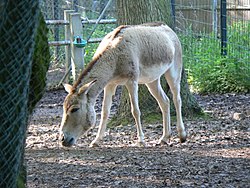| Asinus | |
|---|---|
 | |
| Turkmenian kulan (Equus hemionus kulan) | |
| Scientific classification | |
| Kingdom: | Animalia |
| Phylum: | Chordata |
| Class: | Mammalia |
| Order: | Perissodactyla |
| Family: | Equidae |
| Genus: | Equus |
| Subgenus: | Asinus Gray, 1824 |
| Type species | |
| Equus hemionus | |
| Species | |
Equus africanus Contents | |
 | |
| Range of the three living wild ass species | |
Asinus is a subgenus of Equus that encompasses several subspecies of the Equidae commonly known as wild asses or wild donkeys, characterized by long ears, a lean, straight-backed build, lack of a true withers, a coarse mane and tail, and a reputation for considerable toughness and endurance.
The common donkey is the best-known domesticated representative of the subgenus, with both domesticated and feral varieties. Among the wild ass species, several never-domesticated species live in Asia and Africa, with the extinct European wild ass species formerly inhabiting Europe.